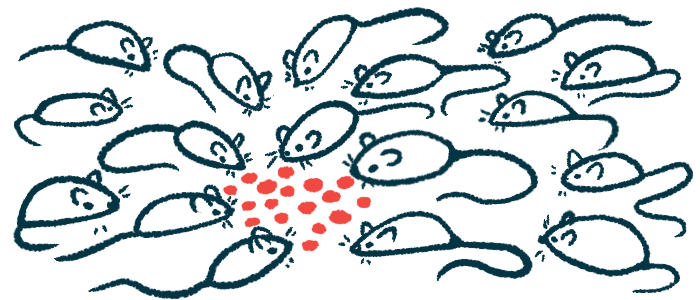Pompe Mouse Model Targets Southern Han Chinese Ancestry
Genetic defect in infantile-onset Pompe disease model studied

Researchers created and characterized an infantile-onset Pompe disease (IOPD) mouse model that carried a genetic defect commonly found among people with Southern Han Chinese ancestry, a study reported.
The model recapitulated most of the signs and symptoms of IOPD and, according to researchers, is ideal to evaluate potential IOPD therapies in preclinical studies.
The mouse study, “CRISPR-mediated generation and characterization of a Gaa homozygous c.1935C>A (p.D645E) Pompe disease knock-in mouse model recapitulating human infantile onset-Pompe disease,” was published in the journal Scientific Reports.
In Pompe, variants of the GAA gene result in a defective GAA enzyme, impairing cells’ ability to degrade glycogen. As a result, glycogen builds up to toxic levels in lysosomes — cells’ recycling centers — and disrupts cellular function, especially in muscles.
Among people with Southern Han Chinese ancestry, the most frequent GAA variant is c.1935C>A — cytosine (C) is changed to adenine (A), two DNA building blocks. This variant causes an infantile-onset type of Pompe disease, marked by heart muscle injury, lung failure, and infantile mortality.
To characterize the underlying disease-related process associated with this particular variant, researchers in the U.S. created a Pompe mouse model and muscle precursor cell line by inserting the c.1935C>A Gaa gene using the gene-editing tool CRISPR.
“We anticipate that this novel [Gaa c.1935C>A] mouse model will be a valuable research tool,” the team wrote. “Altogether, preclinical [models of Pompe] will further accelerate our understanding of how pathogenic [disease-causing] GAA mutations result in variable disease onset, progression, and response to current and future therapeutic strategies.”
Two mouse models
The researchers created two models: mice/cells with one c.1935C>A variant Gaa copy, or heterozygous, like an unaffected human carrier; and mice/cells with two variant Gaa copies, or homozygous, mimicking an affected IOPD patient (knock-in, KI).
In muscle cells, initial experiments confirmed less than 2.3% GAA enzyme activity along with the buildup of glycogen. In mice, healthy or mutant, there were no differences in the activity of the Gaa gene, demonstrating that enzyme function, rather than its production, was impaired.
The team then measured GAA enzyme activity and glycogen levels in brain tissue and different muscle groups, including the heart, the diaphragm in the lower ribs, and the calf. To compare, tissue from mice with the Gaa gene entirely deleted (knock-out, KO) also was examined.
Compared to healthy mice (wild-type, WT), heterozygous mice with one mutant Gaa copy had about half the GAA enzyme activity in each muscle group and brain tissue. In Pompe mice with two defective genes, GAA activity was about 1% of normal.
Across all muscle tissues, both homozygous mutant mice (KI and KO) had abnormally high glycogen levels in lysosomes, whereas, in healthy and heterozygous mice, glycogen levels were similar. There also was a significant increase in glycogen in whole-brain samples of KO mice, but not in the KI mouse model of Pompe.
Autophagic buildup
In Pompe, the harmful buildup of glycogen in lysosomes disrupts autophagy — a cellular process that degrades and eliminates damaged or unnecessary molecules.
“Excessive autophagic build-up is well-documented in PD [Pompe disease] patients and in PD mice, and may be a potential mechanism of [Pompe development],” the researchers wrote.
Consistently, the level of LAMP1, a biomarker for lysosomal storage, was markedly higher in brain tissue samples of Pompe mice than in controls. Autophagy was activated in all muscle cell types and impaired in the diaphragm and calf muscles, but not in the heart muscle, in this model. The researchers noted this result is similar to other Pompe mouse models.
In 3-month-old c.1935C>A mice, an echocardiogram demonstrated early signs of hypertrophic cardiomyopathy, a symptom of Pompe characterized by the thickening of the heart muscle.
Finally, the team tested muscle strength using the standard forelimb grip strength test, in which mice hold a bar and are slowly pulled backward by the tail. Grip strength is the force measured when they lose grip, normalized by body weight.
Drop in grip strength
While there were no differences in body weight between all mice, male but not female Pompe mice showed a significant 19% drop in grip strength compared to controls, “indicating decreased forelimb muscle strength in KI mice,” the team added.
Unlike untreated human IOPD infants, the team noted no infant mortality associated with this KI Pompe model, which was similar to other Pompe models.
The researchers concluded that this Pompe model “demonstrates severe GAA enzyme deficiency and glycogen accumulation; the KI mouse model successfully recapitulates molecular, biochemical, histologic [tissue and cells], and phenotypic [characteristic] aspects of human IOPD.”
“It is an ideal model to assess innovative therapies to treat IOPD, including personalized therapeutic strategies that correct pathogenic variants, restore GAA activity and produce functional phenotypes,” the researchers added.







